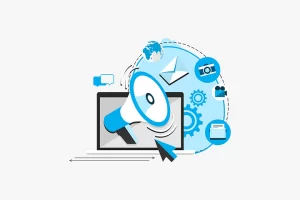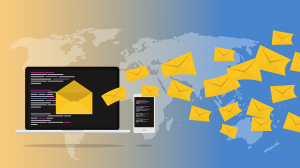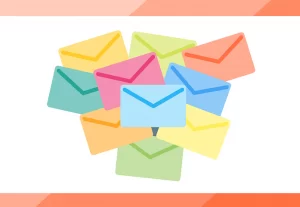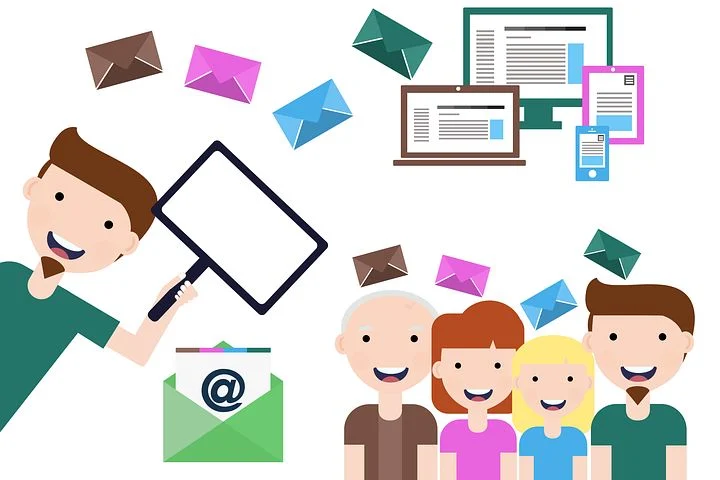The days when email was just a medium used as storage devices are gone. It has now evolved into a powerful means of communication that is simple, instantaneous, and allows you to connect with your target audience. As the necessity for email marketing has increased in importance, so has the profit derived from it.
It’s no secret that email marketing is one of the most effective ways to reach customers. In fact, according to a recent survey by McKinsey & Company, over half of the consumers say they prefer email over other channels for promotional messages.
While users are becoming increasingly resistant to traditional forms of advertising—like commercials and print ads—email is still a relatively untapped resource for companies looking to expand their reach and build a relationship with their customers.
Unfortunately, many businesses still rely on outdated email marketing strategies that no longer work. If your emails aren’t reaching customers the way they used to—or aren’t reaching them at all—it might be time to try something new.
To help you re-energize your email marketing efforts, we’ve compiled a list of some ideas that you can implement right now. These tips will help you get more opens, click-throughs, and overall engagement—all of which lead to increased revenue for your business.
Ready? Let’s get started!

Use the marketing funnel to identify where you need to improve your email marketing.
Identify Your Email Marketing Goals
If you have a plan for your email marketing, it’s much more likely to succeed. To develop an email marketing plan that works for you, it’s important to identify your goals and the most effective way to reach them.
The best way to do this is by using the marketing funnel as a guide. The marketing funnel helps you understand how your customers move through the buying process and what they need at each stage of that process. It can also help you identify where you should focus your efforts so that you’re reaching potential customers when they are most receptive to what you have to offer.
A marketing funnel is a helpful tool for identifying where in the sales process you can improve your email marketing. The stages of the funnel include:
Top of the funnel: At this stage, you are targeting people who may have heard of your company but don’t know much about it. You probably don’t have their email addresses or other contact information, so you’ll need to get that information before you can send them any emails.
Middle of the funnel: These are people who have expressed interest in your brand by signing up for your mailing list, following you on social media, visiting your website, or doing another similar action. They know a little bit about you and may be considering purchasing something from your company. You can use content to directly encourage sales as well as continue educating them about your product or service.
Bottom of the funnel: These are people who are ready to make a purchase, but they want to do more research before committing to a specific brand. Your goal at this point is to convince them that you’re the best brand for them and that they should choose you over anyone else.
The marketing funnel is a framework that can help you position your business in a way that attracts leads and encourages customers to purchase your product or service.
When it comes to email marketing, one of your goals should be using email to guide people through each stage of this funnel. For new subscribers, you might want to send them emails introducing them to your brand and what they can expect from it. For existing subscribers, you might want to send them emails that encourage them to pursue further engagement by visiting your website or calling one of your customer service representatives. And for those who are already engaged with your company, you might want to use email as a means of encouraging them down the final steps towards converting into paying customers.
The marketing funnel is a great framework for understanding how different aspects of email marketing fit together in order to achieve ultimate success.
In the end, creating an effective email marketing campaign is all about striking that balance between optimizing each phase of the funnel for conversions and improving those phases over time to achieve greater results. By doing so, you can begin engaging your customers in a way that establishes them as loyal followers who are intrigued by what you have to offer and continue to be interested in your brand throughout the onboarding process. It’s true that building buzz for a new release or product can be done through several other mediums. But when it comes to marketing and selling your product, using an email marketing strategy has proven itself worthy time and time again.

Increase Your Email Marketing Frequency.
The best way to drive sales is to engage with your audience regularly, and the best way to do that is through Emails!
Let’s get one thing clear: email is the easiest, most cost-effective way to consistently engage with your audience. It’s a fact that companies who are active in email marketing see an average of a 24% increase in revenue.
And if you’re not already sending out emails regularly, or at all? You’re missing out on a huge opportunity to build rapport with your audience and drive sales.
A regular schedule of emails is the best way to stay top of mind with your customers.
We’ve found that the best way to increase revenue is to increase the number of emails you send. So why not start today?
Improve the quality of your emails.
If you’re like most people, you probably spend a lot of time writing emails. But not all emails are created equal—some are more engaging and effective than others.
We’ve put together a list of five quick tips that can help you write better.
emails and make the most of your time:
Perfect your subject line
It’s common knowledge that the subject line is arguably the most important part of any email. Your subject line should be brief, descriptive, and specific. It should describe what’s inside the email so that your recipient knows what to expect and can prioritize it accordingly.
Always be specific
When writing an email, ask yourself what exactly the recipient needs to do after reading it. If you don’t know the answer, don’t send it! Instead, get more information by calling or scheduling a meeting in person. Once you’ve got everything you need, include clear instructions in your email so that It’s obvious what they need to do next.
Keep it short and sweet
You can save yourself and your recipient a lot of time by cutting down on unnecessary words and sentences in your email. When possible, use bullets or numbers to highlight key points instead of writing out long paragraphs. You can also start with a simple greeting like “Hi” or “Hello” instead of “Dear Sir/ or etc.
Use active voice.
It’s easy for people to get stuck in a passive voice when writing an email. You may be trying to avoid sounding aggressive or too direct. However, this usually results in emails that lack clarity and direction, which is not only frustrating to your readers but also wastes their time. Instead of starting with a “maybe” or “perhaps,” choose your verbs carefully and use them to direct the reader’s attention to the next step they need to take.
End with a clear call to action
A call to action encourages your reader to take some kind of action at the end of your email. Your goal is probably to prompt some kind of action from your reader—whether it’s scheduling a meeting or making changes to a document. Make sure that whatever this is, you’re asking for it explicitly in your final paragraph.
Improving the quality of your emails is a matter of understanding what makes an email good and applying that to your own communications. I hope that you were able to gain some insight from this collection of tips on how to improve the quality of your emails.
 Automate your emails.
Automate your emails.
Automating your emails is a great way to save time and create a seamless customer journey. You can set up welcome emails for new subscribers, abandoned cart emails for shoppers that added items to their carts but didn’t complete the purchase, and confirmation emails for customers who have purchased from you.
Automation is a powerful tool to turn one-time buyers into repeat customers and put more money in your pocket. There are many email marketing service providers that offer automation tools, including MailChimp (which we use). Explore your options to find the best solution for you.
Many of the best email marketing tools offer automation, which allows you to send emails without having to manually set them up.
Email automation comes in handy when you want to:
Re-engage existing customers. Send a message whenever someone visits your site for the first time in a while.
Send birthday greetings or holiday wishes to your subscribers.
Send an email series about a specific topic, product, or service.
Automating your emails is a great way to save time and money. But there are some best practices you should follow in order to maximize the effectiveness of your automated marketing emails.
Here are three simple rules to keep in mind when you’re automating your emails:
1. Don’t automate them all. Some messages, especially those that include a promotional offer, should be sent manually. This gives you the opportunity to ensure that they are perfectly designed and written, while also giving you a chance to adjust or personalize each message according to the recipient.
Make sure they feel personal. The whole point of automation is to make sure no one falls through the cracks. But don’t forget that each person receiving an automated email is still an individual with their own needs, interests, behavior patterns, and preferences. Be sure your messages feel authentic and personalized as much as possible so every recipient feels like it was meant for them specifically.
Track performance, always. While it may be tempting to set up a campaign and forget about it, this is never a good idea — especially when it comes to emails sent for marketing purposes. Be sure that you track the performance of every automated email you send out so you can determine whether or not you need to make any changes.
Reduce the number of unsubscribes.
It’s impossible to eliminate unsubscribes completely. Sometimes, even the best email strategy can’t prevent them.
So instead of trying to eliminate unsubscribes, focus on reducing them. The fewer people who unsubscribe, the more profitable your email marketing campaigns will be.
There are several ways to reduce your unsubscribe rate:
1: Segment your list. When you send highly targeted emails to small groups of subscribers with specific needs and interests, they’re less likely to opt-out of future emails.
2: Clean up your lists. Remove email addresses that haven’t been active in a while and those with high bounce rates. Sending emails to these contacts not only lowers your engagement rates but also increases your spam complaint rates and costs you money when an ISP blocks you for spammy behavior.
3: Make it easy for subscribers to opt-out. While most people won’t use this feature, it’s important for those who do want to leave your list. If you make it too difficult or confusing for people to opt out of receiving emails from you, they’ll mark your emails as spam or report you to their ISPs instead.
4: Use an email address that matches your brand. Unsubscribe rates can be higher when the “from” email address is not a recognized name within the company. Try using an email address from someone in your company or at least one that is associated with the company (e.g., info@companyname.com).
5: Experiment with sending frequency and subject lines. If people are opting out because they think you’re sending too much email, try changing up the frequency of your emails or try new subject lines so they don’t feel like they’re getting repetitive content.
6: Ask customers to update their preferences: If a customer wants to stop receiving emails, ask them why they want to leave and if they’d like to receive fewer emails instead. If they’d prefer not to receive certain types of emails or would like a longer gap between messages, it’s worth giving them this option as not every customer will want to leave entirely.
7: Send only relevant content. Make sure the information you’re sending is relevant to the recipient’s interests and needs in order to keep them engaged.
8: Keep it short and sweet. Cut out the fluff and get straight to the point so subscribers spend less time reading your emails and more time taking action.
With a bit of research on your audience and a focus on what they’re truly looking for, you just might be able to cut your unsubscribe rate down to zero. After all, adding value is the best way to keep people coming back.
Furthermore, don’t be afraid to try new things: make sure to stay on top of your competitors, and analyze what they’re doing right—and what they’re doing wrong. Optimize your unsubscribe process and get ready for some more signed-up email addresses.
Make sure you’re using the right tools to test and optimize your email marketing campaigns.
Email Marketing is a powerful marketing tool, but you can’t just rely on it. You need to know that your email marketing campaigns are working and improving. The best way to do this is through testing and optimization.
As a business owner, you may not have the time or resources to dedicate an entire department to testing and optimizing your email marketing campaigns. And that’s okay! There are tons of tools available online to help you stay focused on your business while still making sure that your email is performing well at all times.
We’ve put together a list of some of the best tools for testing and optimizing your email marketing campaigns so you can get the most out of them.
1) A/B Testing
A/B testing is a great way to see what works best for your audience. It allows you to test two different versions of an email and see which one performs better in terms of open rates, click-throughs, conversions, etc., by sending them both out simultaneously to split lists of subscribers. It’s easy to set up A/B tests with most email marketing platforms, including MailChimp, ConvertKit, Drip, and more.
2) Multi-Variant Testing
Multi-variant testing is a testing method that allows you to test multiple versions of an Email Campaign in order to determine which one produces better results. This can be done using A/B Testing, where two different versions of the same Email Campaign are sent to two different segments of your audience, or Multivariate Testing (MVT), where multiple variations of a single element or multiple elements are sent to your audience.
3. Cross-Device Testing
Today’s Internet users aren’t limited to viewing emails on their computers; many choose to open their emails on mobile devices as well. As such, it’s important for marketers to ensure that their campaigns look good on every device, which can be achieved via cross-device testing. The same methodology used for Multi-Variant Testing can be used for Cross-Device Testing; however, instead of testing different versions of an Email Campaign, you would be testing how your campaign looks on different devices (such as desktop computers and mobile phones)
4. Real-Time Monitoring
Email deliverability can be affected by many factors that are outside of your control, including bad IP addresses and blacklists. Real-time monitoring tools allow you to see how many emails are being delivered in real-time so that you can catch any problems early on and react accordingly. You can use a tool like Mail Monitor to track your open rate, deliverability rate, bounce rate, click rate, and more on a daily basis.
Email Marketing Analytics
How do you figure out which tactics work best? By tracking your results, of course!
You can use Google Analytics to track email subscribers and then better understand why some people opt for your products or services while others don’t.
With Google Analytics, you can also see which types of content appeal most to your readers, as well as their preferred time zones. This information can help with your email marketing strategy too.
5. Email Automation
It can be time-consuming to send emails manually to every client on your list. But with email automation, you can send emails on autopilot while still keeping them personalized and relevant.
Make sure that you’re compliant with privacy laws (such as GDPR, CASL, and CAN-SPAM).
If your business offers products or services to people in the European Union (EU), you must comply with the General Data Protection Regulation (GDPR). This regulation allows consumers to understand how their data is collected and used.
Similarly, if you’re sending emails to recipients in Canada, you must comply with Canada’s Anti-Spam Legislation (CASL) and the U.S. CAN-SPAM Act of 2003. These rules help protect consumers from receiving unsolicited commercial emails (spam).
You can request consent from your website visitors through an opt-in box or web form. Make sure that you get explicit consent from your customers before adding them to your mailing list.
The CAN-SPAM Act is a law that sets the rules for commercial email and requires sending marketing emails to opt-in subscribers only. The Federal Trade Commission has published detailed guidelines for compliance with this law, which apply only to commercial messages sent by US companies and marketers. Commercial messages include any message that advertises or promotes a product or service.
The FTC’s requirements for complying with the CAN-SPAM Act are:
Don’t use false or misleading header information. Your “From,” “To,” “Reply-To,” and routing information – including the originating domain name and email address – must be accurate and identify the person who initiated the message.
Don’t use deceptive subject lines. The subject line must accurately reflect the content of the message.
Identify the message as an ad. The law gives you a lot of leeway in how to do this, but you must disclose clearly and conspicuously that your message is an advertisement.
Tell recipients where you’re located. Your message must include your valid physical postal address. This can be your current street address or a post office box you’ve registered.
The CAN-SPAM Act does not regulate transactional or relationship messages, such as those sent by banks, airlines, online stores, etc., regarding the status of a customer’s account. Such messages are regulated under the FTC’s general rules of fair practices.
If you follow these tips above, your email marketing revenue will increase dramatically.
The potential for increased sales is huge and the potential for a higher return on your marketing investment is even bigger. By aligning your marketing tactics with customer behavior and turning it into a true strategy, you can build more trust, loyalty, and revenue.
At the end of the day, how much that matters is up to you!
